Using GAMs to Explore the Influence Factors and Their Interactions on Land Surface Temperature: A Case Study in Nanjing
Abstract
:1. Introduction
2. Study Area and Data
2.1. Study Area
2.2. Data
2.2.1. Land Surface Temperature
2.2.2. Influencing Factors
- (1)
- Land Use and Land Cover
- (2)
- Ecological Environmental Factor
- (3)
- Socioeconomic factor
3. Methodology
3.1. Generalized Additive Models (GAMs)
3.2. Mann–Kendall Trend Test
3.3. Correlation Analysis
3.4. Akaike Information Criterion
3.5. Model Configurations
4. Results and Analysis
4.1. Spatiotemporal Characteristics of LST
4.2. Temporal Trend Analysis of LST
4.3. Correlation between Influencing Factors
4.4. Results of Multivariate GAMs (MGAM)
4.5. Results of Multivariate GAMs with Interaction (MGAMI)
5. Discussion
6. Conclusions
Author Contributions
Funding
Data Availability Statement
Conflicts of Interest
References
- Jiang, K.; Pan, Z.; Pan, F.; Teuling, A.J.; Han, G.; An, P.; Chen, X.; Wang, J.; Song, Y.; Cheng, L.; et al. Combined influence of soil moisture and atmospheric humidity on land surface temperature under different climatic background. iScience 2023, 26, 106837. [Google Scholar] [CrossRef] [PubMed]
- Yu, Y.; Duan, S.B.; Li, Z.L.; Chang, S.; Xing, Z.; Leng, P.; Gao, M. Interannual Spatiotemporal Variations of Land Surface Temperature in China From 2003 to 2018. IEEE J. Sel. Top. Appl. Earth Obs. Remote Sens. 2021, 14, 1783–1795. [Google Scholar] [CrossRef]
- Yu, Y.; Fang, S.; Zhuo, W. Revealing the Driving Mechanisms of Land Surface Temperature Spatial Heterogeneity and Its Sensitive Regions in China Based on GeoDetector. Remote Sens. 2023, 15, 2814. [Google Scholar] [CrossRef]
- Li, Z.-L.; Tang, B.-H.; Wu, H.; Ren, H.; Yan, G.; Wan, Z.; Trigo, I.F.; Sobrino, J.A. Satellite-derived land surface temperature: Current status and perspectives. Remote Sens. Environ. 2013, 131, 14–37. [Google Scholar] [CrossRef]
- Yang, C.; Yan, F.; Lei, X.; Ding, X.; Zheng, Y.; Liu, L.; Zhang, S. Investigating Seasonal Effects of Dominant Driving Factors on Urban Land Surface Temperature in a Snow-Climate City in China. Remote Sens. 2020, 12, 3006. [Google Scholar] [CrossRef]
- Garzón, J.; Molina, I.; Velasco, J.; Calabia, A. A Remote Sensing Approach for Surface Urban Heat Island Modeling in a Tropical Colombian City Using Regression Analysis and Machine Learning Algorithms. Remote Sens. 2021, 13, 4256. [Google Scholar] [CrossRef]
- Liu, M.; Ma, H.; Bai, Y. Understanding the Drivers of Land Surface Temperature Based on Multisource Data: A Spatial Econometric Perspective. IEEE J. Sel. Top. Appl. Earth Obs. Remote Sens. 2021, 14, 12263–12272. [Google Scholar] [CrossRef]
- Liu, K.; Li, X.; Wang, S.; Li, Y. Investigating the impacts of driving factors on urban heat islands in southern China from 2003 to 2015. J. Clean. Prod. 2020, 254, 120141. [Google Scholar] [CrossRef]
- Joly, D.; Bois, B.; Zakšek, K. Rank-Ordering of topographic variables correlated with temperature. Atmos. Clim. Sci. 2012, 2, 139–147. [Google Scholar] [CrossRef]
- Min, M.; Lin, C.; Duan, X.; Jin, Z.; Zhang, L. Spatial distribution and driving force analysis of urban heat island effect based on raster data: A case study of the Nanjing metropolitan area, China. Sustain. Cities Soc. 2019, 50, 101637. [Google Scholar] [CrossRef]
- Zhou, S.; Liu, D.; Zhu, M.; Tang, W.; Chi, Q.; Ye, S.; Xu, S.; Cui, Y. Temporal and Spatial Variation of Land Surface Temperature and Its Driving Factors in Zhengzhou City in China from 2005 to 2020. Remote Sens. 2022, 14, 4281. [Google Scholar] [CrossRef]
- Wu, Z.; Yao, L.; Zhuang, M.; Ren, Y. Detecting factors controlling spatial patterns in urban land surface temperatures: A case study of Beijing. Sustain. Cities Soc. 2020, 63, 102454. [Google Scholar] [CrossRef]
- Guo, J.; Han, G.; Xie, Y.; Cai, Z.; Zhao, Y. Exploring the relationships between urban spatial form factors and land surface temperature in mountainous area: A case study in Chongqing city, China. Sustain. Cities Soc. 2020, 61, 102286. [Google Scholar] [CrossRef]
- Gunawardena, K.R.; Wells, M.J.; Kershaw, T. Utilising green and bluespace to mitigate urban heat island intensity. Sci. Total Environ. 2017, 584–585, 1040–1055. [Google Scholar] [CrossRef] [PubMed]
- Meng, Q.; Liu, W.; Zhang, L.; Allam, M.; Bi, Y.; Hu, X.; Gao, J.; Hu, D.; Jancsó, T. Relationships between Land Surface Temperatures and Neighboring Environment in Highly Urbanized Areas: Seasonal and Scale Effects Analyses of Beijing, China. Remote Sens. 2022, 14, 4340. [Google Scholar] [CrossRef]
- Peng, J.; Jia, J.; Liu, Y.; Li, H.; Wu, J. Seasonal contrast of the dominant factors for spatial distribution of land surface temperature in urban areas. Remote Sens. Environ. 2018, 215, 255–267. [Google Scholar] [CrossRef]
- Abbas, A.; He, Q.; Jin, L.L.; Li, J.L.; Salam, A.; Lu, B.; Yasheng, Y. Spatio-Temporal Changes of Land Surface Temperature and the Influencing Factors in the Tarim Basin, Northwest China. Remote Sens. 2021, 13, 3792. [Google Scholar] [CrossRef]
- Nabizada, A.F.; Rousta, I.; Dalvi, M.; Olafsson, H.; Siedliska, A.; Baranowski, P.; Krzyszczak, J. Spatial and Temporal Assessment of Remotely Sensed Land Surface Temperature Variability in Afghanistan during 2000–2021. Climate 2022, 10, 111. [Google Scholar] [CrossRef]
- Tian, H.; Liu, L.; Zhang, Z.; Chen, H.; Zhang, X.; Wang, T.; Kang, Z. Spatiotemporal diversity and attribution analysis of land surface temperature in China from 2001 to 2020. Acta Geogr. Sin. 2022, 77, 1713–1729. [Google Scholar]
- Yao, T.D.; Jiao, K.Q.; Yang, M. Precipitation variations recorded in Guliya ice core in the past 400 years. Prog. Nat. Sci. 2000, 10, 292–293. [Google Scholar]
- Littmann, T. Rainfall, Temperature and Dust Storm Anomalies in the African Sahel. Geogr. J. 1991, 157, 136–160. [Google Scholar] [CrossRef]
- Duan, K.; Yao, T.; Thompson, L.G. Response of monsoon precipitation in the Himalayas to global warming. J. Geophys. Res. Atmos. 2006, 111, D19110. [Google Scholar] [CrossRef]
- Aigang, L. Precipitation effects on temperature—A case study in China. J. Earth Sci. 2011, 22, 792–798. [Google Scholar] [CrossRef]
- Kauppinen, J.; Heinonen, J.; Malmi, P. Influence of Relative Humidity and Clouds on the Global Mean Surface Temperature. Energy Environ. 2014, 25, 389–399. [Google Scholar] [CrossRef]
- Ji, Y.; Peng, Y.; Li, Z.; Li, J.; Liu, S.; Cai, X.; Yin, Y.; Feng, T. Driving Mechanism of Differentiation in Urban Thermal Environment during Rapid Urbanization. Remote Sens. 2023, 15, 2075. [Google Scholar] [CrossRef]
- Rongbo, X.; Ouyang, Z.; Li, W.; Schienke, E.; Zhang, Z. Land Surface Temperature Variation and Major Factors in Beijing, China. Photogramm. Eng. Remote Sens. 2008, 74, 451–461. [Google Scholar] [CrossRef]
- Song, Z.; Yang, H.; Huang, X.; Yu, W.; Huang, J.; Ma, M. The spatiotemporal pattern and influencing factors of land surface temperature change in China from 2003 to 2019. Int. J. Appl. Earth Obs. Geoinf. 2021, 104, 102537. [Google Scholar] [CrossRef]
- Chen, X.; Yang, L. Temperature and industrial output: Firm-level evidence from China. J. Environ. Econ. Manag. 2019, 95, 257–274. [Google Scholar] [CrossRef]
- Tao, A.X. Study on Environment Engineering with Influence of Human Factors on the Temperature Variation in Beijing City. Adv. Mater. Res. 2013, 788, 400–404. [Google Scholar] [CrossRef]
- Peng, X.; Wu, W.; Zheng, Y.; Sun, J.; Hu, T.; Wang, P. Correlation analysis of land surface temperature and topographic elements in Hangzhou, China. Sci. Rep. 2020, 10, 10451. [Google Scholar] [CrossRef] [PubMed]
- Guo, Y.; Zhang, C. Analysis of Driving Force and Driving Mechanism of the Spatial Change of LST Based on Landsat 8. J. Indian Soc. Remote Sens. 2022, 50, 1787–1801. [Google Scholar] [CrossRef]
- He, J.; Zhao, W.; Li, A.; Wen, F.; Yu, D. The impact of the terrain effect on land surface temperature variation based on Landsat-8 observations in mountainous areas. Int. J. Remote Sens. 2019, 40, 1808–1827. [Google Scholar] [CrossRef]
- Rao, Y.; Dai, J.; Dai, D.; He, Q. Effect of urban growth pattern on land surface temperature in China: A multi-scale landscape analysis of 338 cities. Land. Use Policy 2021, 103, 105314. [Google Scholar] [CrossRef]
- Jung, M.C.; Dyson, K.; Alberti, M. Urban Landscape Heterogeneity Influences the Relationship between Tree Canopy and Land Surface Temperature. Urban. For. Urban. Green. 2021, 57, 126930. [Google Scholar] [CrossRef]
- Xi, M.; Zhang, W.; Li, W.; Liu, H.; Zheng, H. Distinguishing Dominant Drivers on LST Dynamics in the Qinling-Daba Mountains in Central China from 2000 to 2020. Remote Sens. 2023, 15, 878. [Google Scholar] [CrossRef]
- Zhao, W.; Duan, S.-B.; Li, A.; Yin, G. A practical method for reducing terrain effect on land surface temperature using random forest regression. Remote Sens. Environ. 2019, 221, 635–649. [Google Scholar] [CrossRef]
- Hou, H.; Su, H.; Liu, K.; Li, X.; Chen, S.; Wang, W.; Lin, J. Driving forces of UHI changes in China's major cities from the perspective of land surface energy balance. Sci. Total Environ. 2022, 829, 154710. [Google Scholar] [CrossRef] [PubMed]
- Wu, X.; Wang, L.; Yao, R.; Luo, M.; Li, X. Identifying the dominant driving factors of heat waves in the North China Plain. Atmos. Res. 2021, 252, 105458. [Google Scholar] [CrossRef]
- de Brogniez, D.; Ballabio, C.; Stevens, A.; Jones, R.J.A.; Montanarella, L.; van Wesemael, B. A map of the topsoil organic carbon content of Europe generated by a generalized additive model. Eur. J. Soil Sci. 2015, 66, 121–134. [Google Scholar] [CrossRef]
- Ma, Y.; Ma, B.; Jiao, H.; Zhang, Y.; Xin, J.; Yu, Z. An analysis of the effects of weather and air pollution on tropospheric ozone using a generalized additive model in Western China: Lanzhou, Gansu. Atmos. Environ. 2020, 224, 117342. [Google Scholar] [CrossRef]
- Ascensão, F.; Ribeiro, Y.G.G.; Campos, Z.; Yogui, D.R.; Desbiez, A.L.J. Forecasting seasonal peaks in roadkill patterns for improving road management. J. Environ. Manag. 2022, 321, 115903. [Google Scholar] [CrossRef] [PubMed]
- Becker, N.; Rust, H.; Ulbrich, U. Weather impacts on various types of road crashes: A quantitative analysis using generalized additive models. Eur. Transp. Res. Rev. 2022, 14, 37. [Google Scholar] [CrossRef]
- Dastoorpoor, M.; Khanjani, N.; Moradgholi, A.; Sarizadeh, R.; Cheraghi, M.; Estebsari, F. Correction to: Prenatal exposure to ambient air pollution and adverse pregnancy outcomes in Ahvaz, Iran: A generalized additive model. Int. Arch. Occup. Environ. Health 2022, 95, 1805. [Google Scholar] [CrossRef] [PubMed]
- Dominici, F.; McDermott, A.; Zeger, S.L.; Samet, J.M. On the Use of Generalized Additive Models in Time-Series Studies of Air Pollution and Health. Am. J. Epidemiol. 2002, 156, 193–203. [Google Scholar] [CrossRef] [PubMed]
- Hart, R.; Pedersen, W.; Skardhamar, T. Blowing in the wind? Testing the effect of weather on the spatial distribution of crime using Generalized Additive Models. Crime. Sci. 2022, 11, 9. [Google Scholar] [CrossRef] [PubMed]
- Khoda Bakhshi, A.; Ahmed, M.M. Real-time crash prediction for a long low-traffic volume corridor using corrected-impurity importance and semi-parametric generalized additive model. J. Transp. Saf. Secur. 2022, 14, 1165–1200. [Google Scholar] [CrossRef]
- Zhang, Y.; Zhou, R.; Hu, D.; Chen, J.; Xu, L. Modelling driving factors of PM2.5 concentrations in port cities of the Yangtze River Delta. Mar. Pollut. Bull. 2022, 184, 114131. [Google Scholar] [CrossRef] [PubMed]
- Peng, S. 1-km Monthly Mean Temperature Dataset for China (1901–2022). 2020. Available online: https://cstr.cn/18406.11.Meteoro.tpdc.270961 (accessed on 14 July 2023).
- Peng, S.; Ding, Y.; Liu, W.; Li, Z. 1 km monthly temperature and precipitation dataset for China from 1901 to 2017. Earth Syst. Sci. Data 2019, 11, 1931–1946. [Google Scholar] [CrossRef]
- Stott, P.A.; Tett, S.F.B.; Jones, G.S.; Allen, M.R.; Mitchell, J.F.B.; Jenkins, G.J. External Control of 20th Century Temperature by Natural and Anthropogenic Forcings. Science 2000, 290, 2133–2137. [Google Scholar] [CrossRef] [PubMed]
- Yang, J.; Huang, X. The 30 m annual land cover dataset and its dynamics in China from 1990 to 2021. Earth Syst. Sci. Data 2022, 13, 3907–3925. [Google Scholar] [CrossRef]
- Wood, S.N. Generalized Additive Models: An Introduction with R, 2nd ed.; Chapman and Hall/CRC: Boca Raton, FL, USA, 2017. [Google Scholar]
- Akaike, H. A new look at the statistical model identification. IEEE Trans. Autom. Control 1974, 19, 716–723. [Google Scholar] [CrossRef]
- Sutherland, C.; Hare, D.; Johnson, P.J.; Linden, D.W.; Montgomery, R.A.; Droge, E. Practical advice on variable selection and reporting using Akaike information criterion. Proc. R. Soc. B-Biol. Sci. 2023, 290, 20231261. [Google Scholar] [CrossRef] [PubMed]
- Burnham, K.P.; Anderson, D.R. Advanced Issues and Deeper Insights. In Model Selection and Multimodel Inference: A Practical Information-Theoretic Approach; Springer: New York, NY, USA, 2002. [Google Scholar]
- Ramsay, T.O.; Burnett, R.T.; Krewski, D. The effect of concurvity in generalized additive models linking mortality to ambient particulate matter. Epidemiology 2003, 14, 18–23. [Google Scholar] [CrossRef] [PubMed]
- Ross, N. Generalized Additive Models in R: A Free Interactive Course. Available online: https://noamross.github.io/gams-in-r-course/ (accessed on 10 March 2024).
- Zhou, D.; Xiao, J.; Frolking, S.; Liu, S.; Zhang, L.; Cui, Y.; Zhou, G. Croplands intensify regional and global warming according to satellite observations. Remote Sens. Environ. 2021, 264, 112585. [Google Scholar] [CrossRef]
- Zhu, M.; Liu, D.; Tang, W.; Chi, Q.; Zhao, X.; Xu, S.; Ye, S.; Wang, Y.; Cui, Y.; Zhou, S. Exploring the Ecological Climate Effects Based on Five Land Use Types: A Case Study of the Huang-Huai-Hai River Basin in China. Land 2022, 11, 265. [Google Scholar] [CrossRef]
- Malik, A.; Kumar, A.; Guhathakurta, P.; Kisi, O. Spatial-temporal trend analysis of seasonal and annual rainfall (1966–2015) using innovative trend analysis method with significance test. Arab. J. Geosci. 2019, 12, 328. [Google Scholar] [CrossRef]
- Walcek, C. Cloud Cover and Its Relationship to Relative Humidity during a Springtime Midlatitude Cyclone. Mon. Weather. Rev. -Mon. Weather. Rev. 1994, 122, 1021–1035. [Google Scholar] [CrossRef]
- He, Z.W.; Tang, B.H. Spatiotemporal change patterns and driving factors of land surface temperature in the Yunnan-Kweichow Plateau from 2000 to 2020. Sci. Total Environ. 2023, 896, 165288. [Google Scholar] [CrossRef] [PubMed]
- Ma, X.; Peng, S. Assessing the quantitative relationships between the impervious surface area and surface heat island effect during urban expansion. PeerJ 2021, 9, e11854. [Google Scholar] [CrossRef] [PubMed]
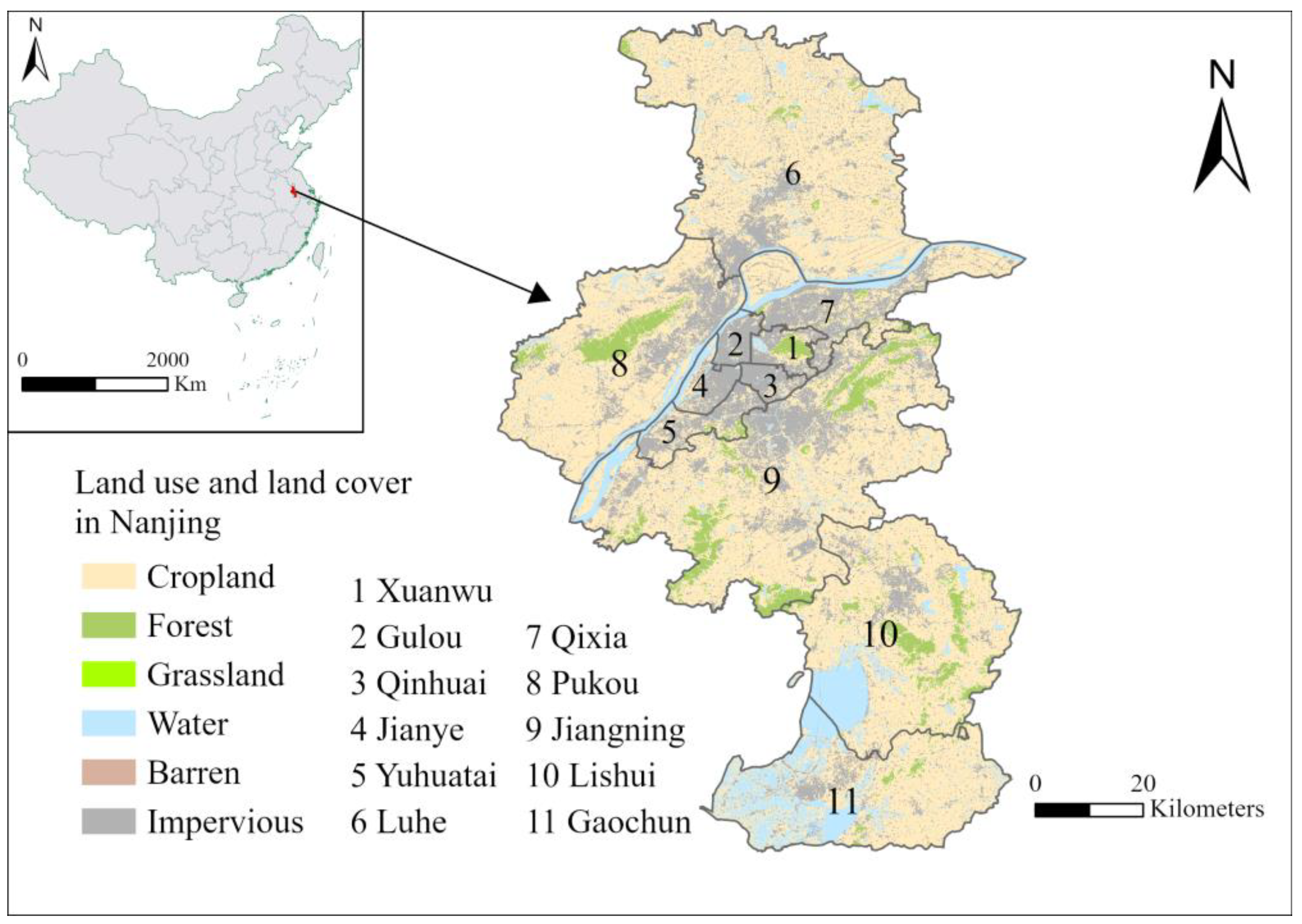

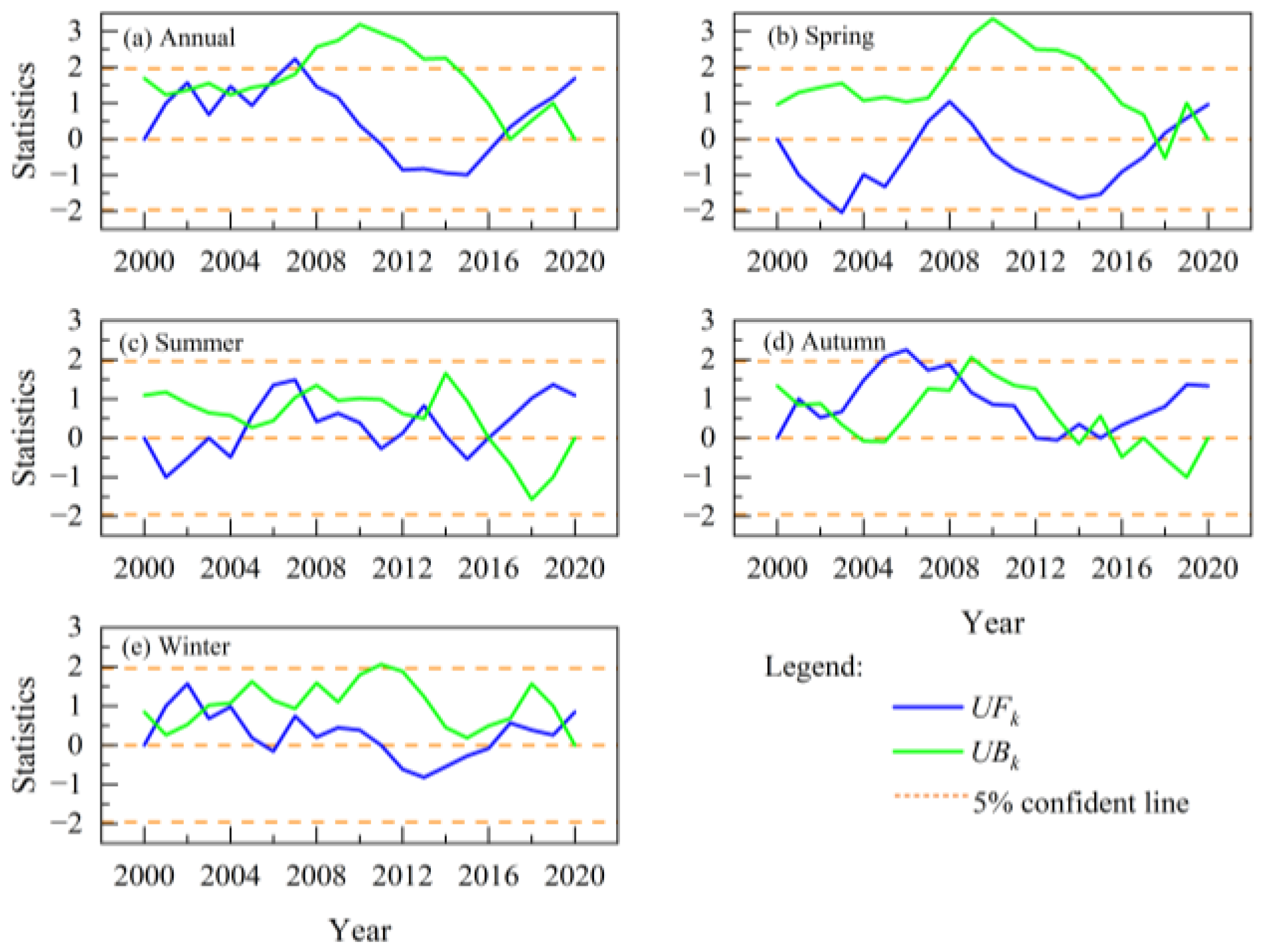
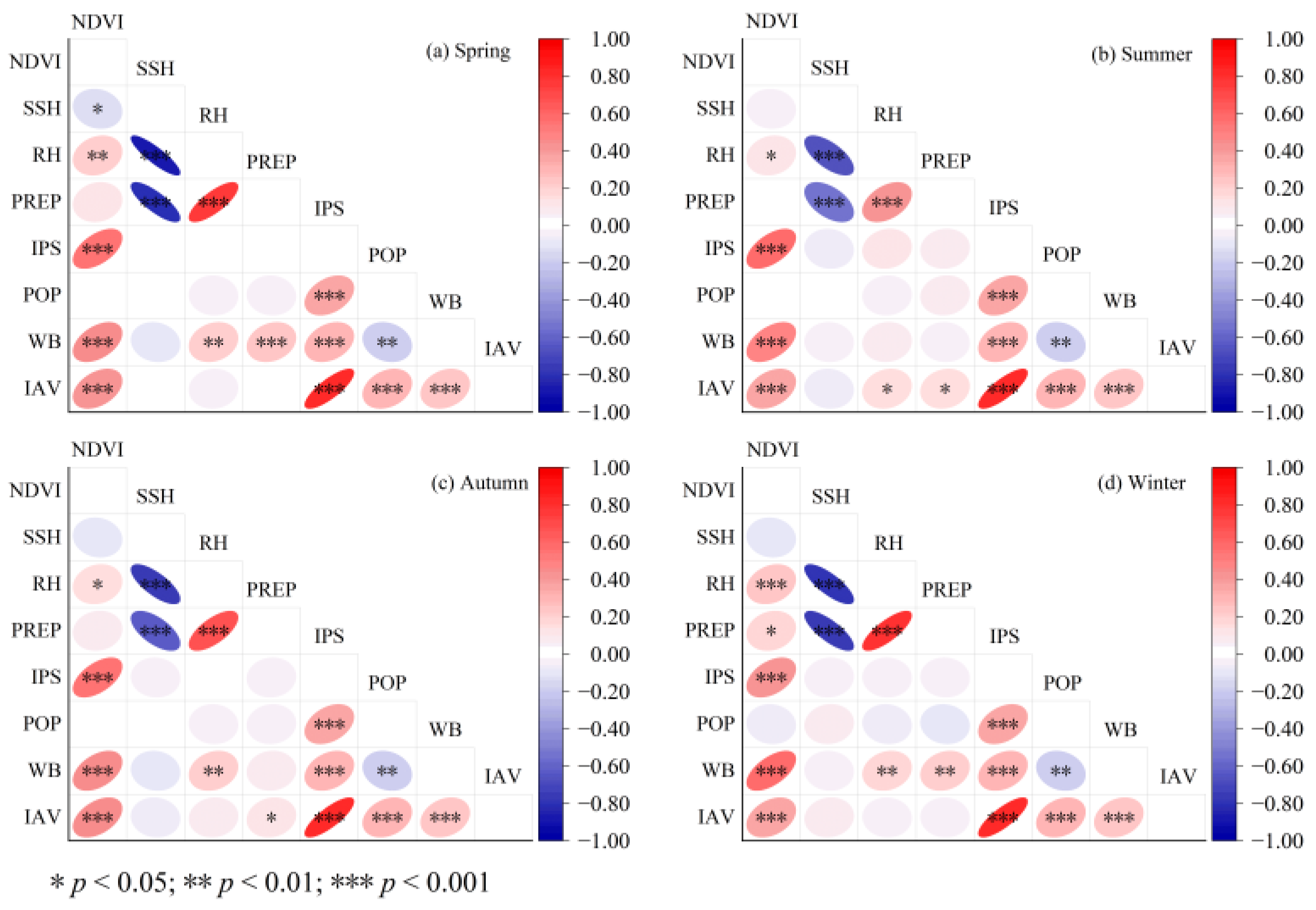
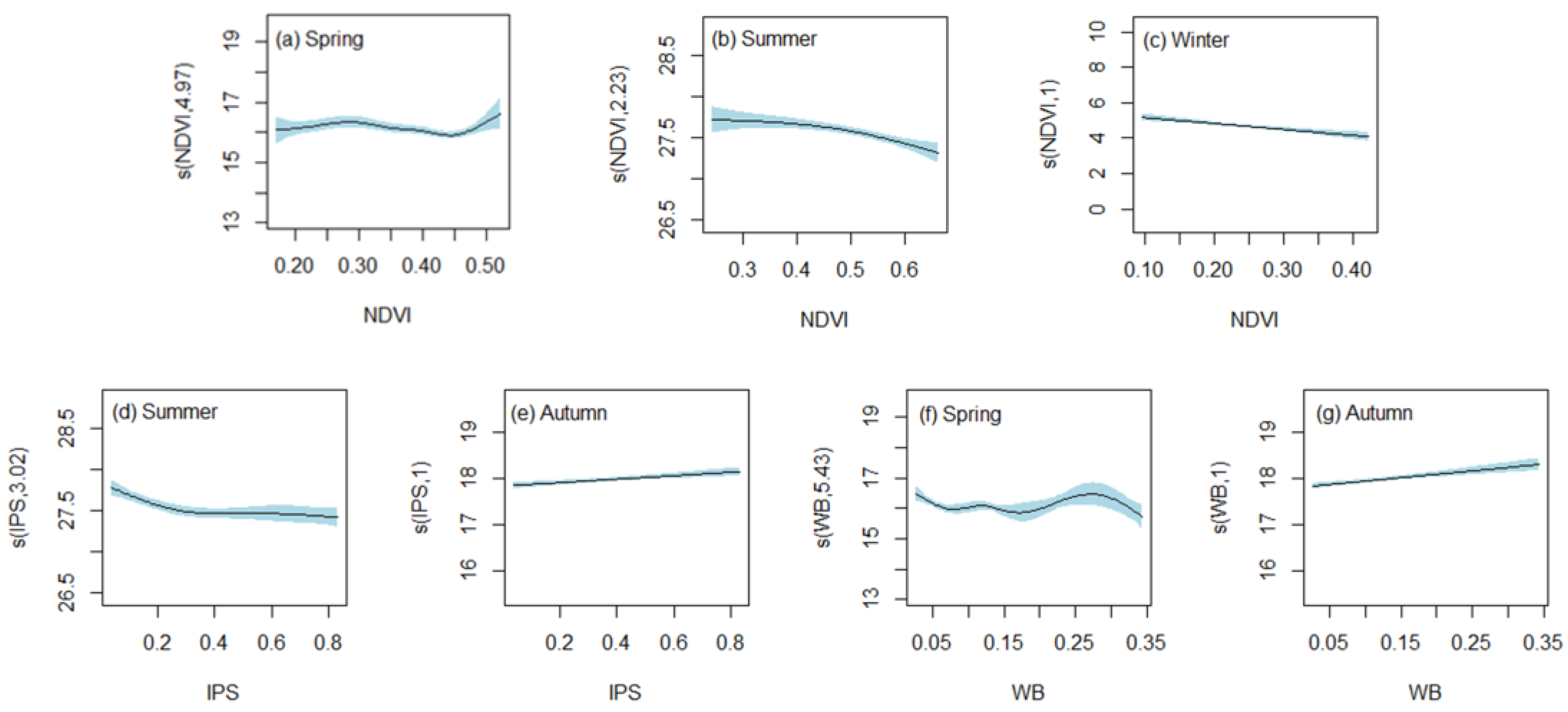
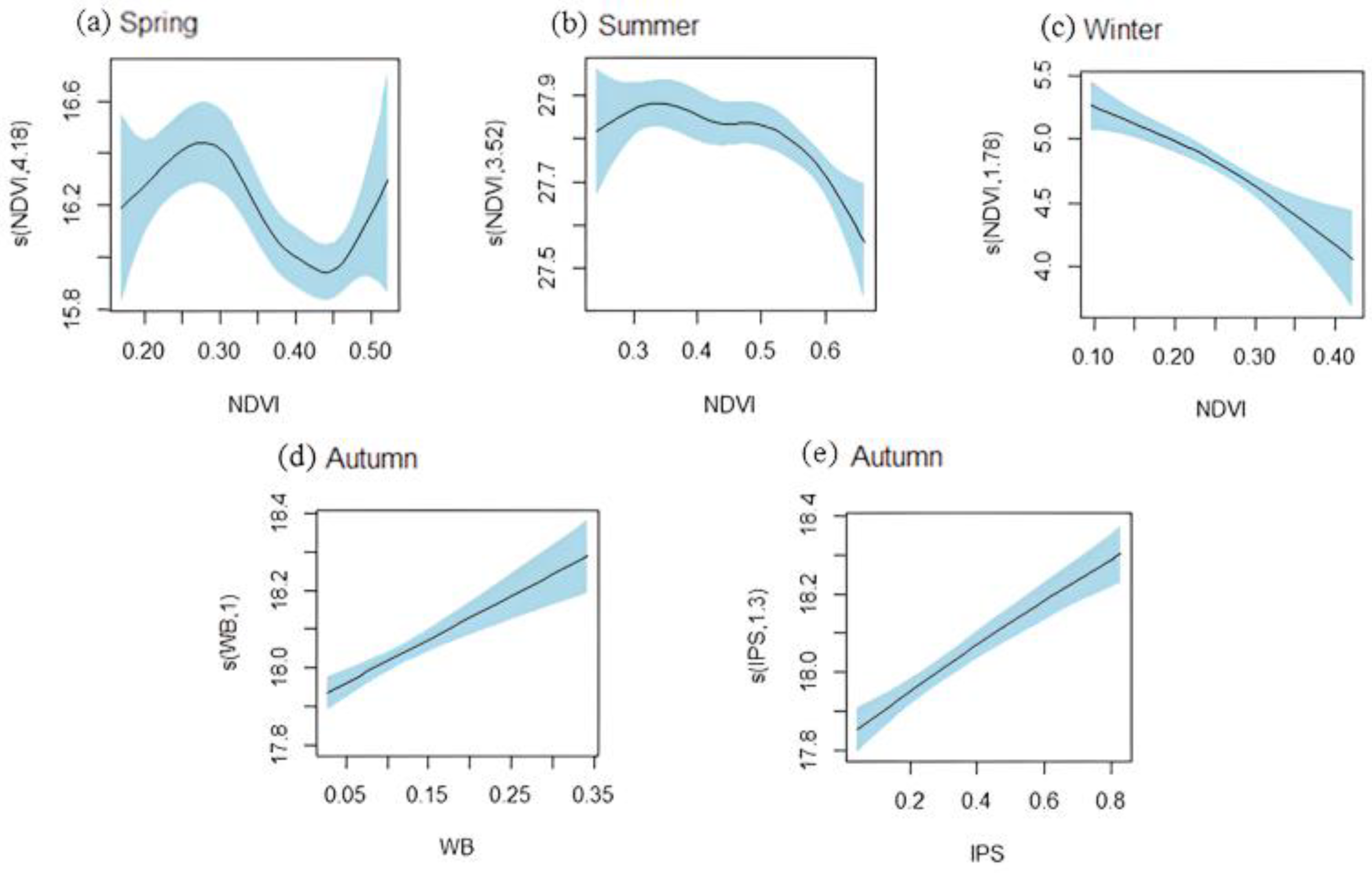
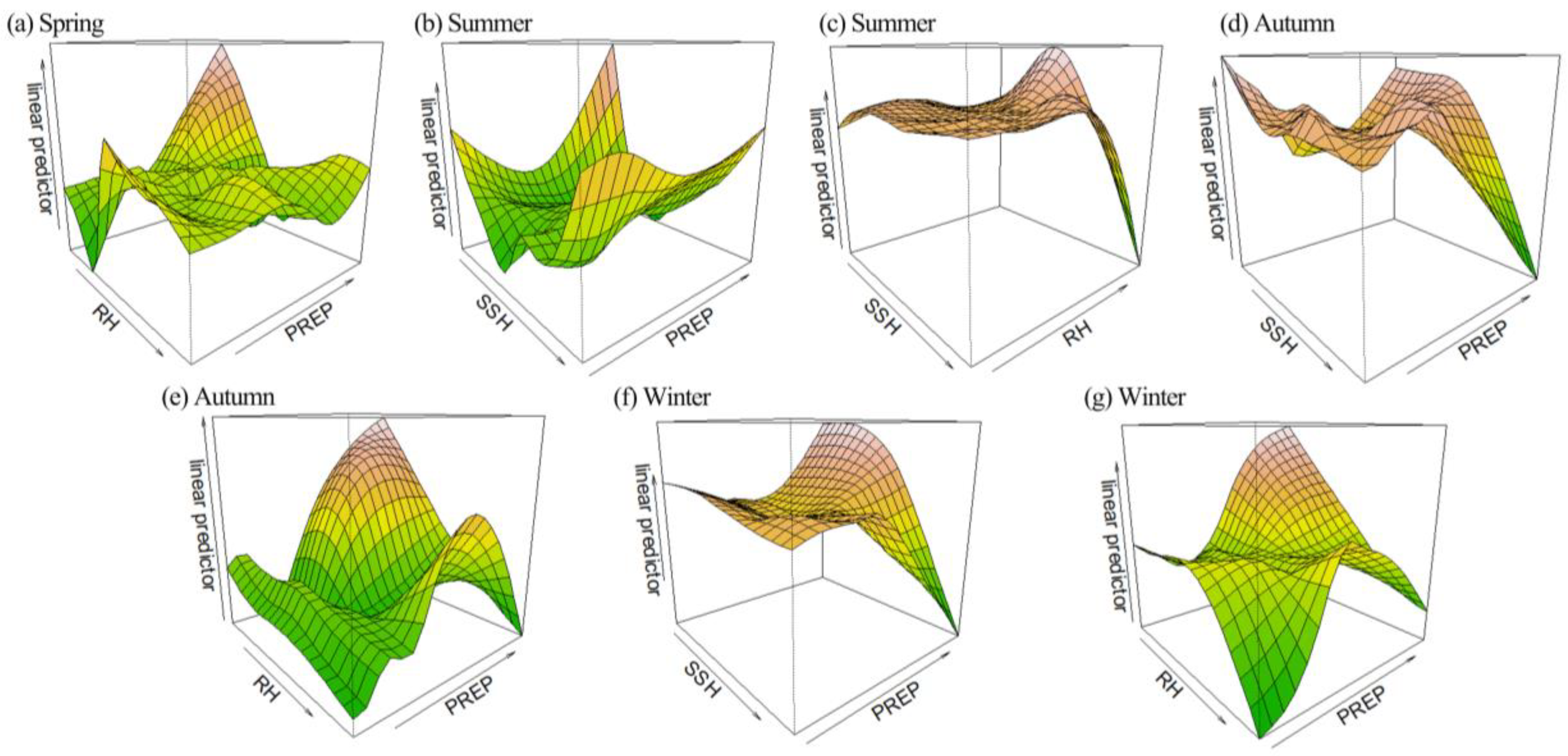

| Category | Influencing Factors | Data Structures | Units | Time Scale |
|---|---|---|---|---|
| LULC | IPS | Raster data | % | Annual |
| WB | Raster data | % | Annual | |
| NDVI | Raster data | - | Monthly | |
| Ecological environmental factor | PREP | Station data | mm | Monthly |
| SSH | Station data | hour | Monthly | |
| RH | Station data | % | Monthly | |
| Socioeconomic factor | PD | Raster data | person/km2 | Annual |
| IAV | District data | billion RMB/km2 | Annual |
| Season | IFs | edf | F | p-Value | DE | adj-R2 |
|---|---|---|---|---|---|---|
| Spring | SSH | 5.368 | 9.838 | <2.00 × 10−16 *** | 59.2% | 0.537 |
| RH | 5.782 | 7.110 | <2.00 × 10−16 *** | |||
| PREP | 5.796 | 3.976 | 5.41 × 10−16 *** | |||
| WB | 5.430 | 3.115 | 4.98 × 10−3 ** | |||
| NDVI | 4.973 | 2.988 | 7.60 × 10−3 ** | |||
| Summer | SSH | 8.183 | 39.503 | <2.00 × 10−16 *** | 83.7% | 0.816 |
| RH | 7.362 | 12.754 | <2.00 × 10−16 *** | |||
| NDVI | 2.230 | 8.927 | 5.58 × 10−5 *** | |||
| PREP | 4.997 | 7.826 | <2.00 × 10−16 *** | |||
| IPS | 3.020 | 7.224 | 4.66 × 10−5 *** | |||
| Autumn | WB | 1 | 28.054 | 9.83 × 10−7 *** | 67.0% | 0.628 |
| IPS | 1.001 | 18.648 | 2.47 × 10−5 *** | |||
| PREP | 7.467 | 12.449 | <2.00 × 10−16 *** | |||
| SSH | 10.177 | 7.606 | <2.00 × 10−16 *** | |||
| RH | 5.937 | 7.314 | <2.00 × 10−16 *** | |||
| Winter | SSH | 6.603 | 34.266 | <2.00 × 10−16 *** | 70.6% | 0.672 |
| NDVI | 1 | 26.427 | 7.71 × 10−7 *** | |||
| RH | 7.720 | 19.662 | <2.00 × 10−16 *** | |||
| PREP | 8.518 | 6.981 | <2.00 × 10−16 *** |
| Season | IFs | edf | F | p-Value | DE | adj-R2 |
|---|---|---|---|---|---|---|
| Spring | (RH, PREP) | 26.706 | 7.272 | <2.00 × 10−16 *** | 61.5% | 0.555 |
| NDVI | 4.178 | 6.085 | 2.48 × 10−5 *** | |||
| Summer | (SSH, RH) | 35.382 | 9.097 | <2.00 × 10−16 *** | 90.9% | 0.879 |
| (SSH, PREP) | 18.304 | 5.520 | <2.00 × 10−16 *** | |||
| NDVI | 3.037 | 4.478 | 2.20 × 10−3 ** | |||
| Autumn | IPS | 1 | 70.249 | <2.00 × 10−16 *** | 84.9% | 0.816 |
| WB | 1 | 29.979 | 6.55 × 10−7 *** | |||
| (SSH, PREP) | 28.230 | 14.472 | <2.00 × 10−16 *** | |||
| (RH, PREP) | 11.050 | 8.472 | <2.00 × 10−16 *** | |||
| Winter | NDVI | 1.623 | 19.050 | <2.00 × 10−16 *** | 86.0% | 0.820 |
| (SSH, PREP) | 19.960 | 16.610 | <2.00 × 10−16 *** | |||
| (RH, PREP) | 30.616 | 13.190 | <2.00 × 10−16 *** |
| Model | Spring | Summer | Autumn | Winter |
|---|---|---|---|---|
| MGAM | 319.004 | −19.932 | 136.047 | 443.268 |
| MGAMI | 308.597 | −80.793 | −17.888 | 327.653 |
Disclaimer/Publisher’s Note: The statements, opinions and data contained in all publications are solely those of the individual author(s) and contributor(s) and not of MDPI and/or the editor(s). MDPI and/or the editor(s) disclaim responsibility for any injury to people or property resulting from any ideas, methods, instructions or products referred to in the content. |
© 2024 by the authors. Licensee MDPI, Basel, Switzerland. This article is an open access article distributed under the terms and conditions of the Creative Commons Attribution (CC BY) license (https://creativecommons.org/licenses/by/4.0/).
Share and Cite
Zhang, X.; Yang, F.; Zhang, J.; Dai, Q. Using GAMs to Explore the Influence Factors and Their Interactions on Land Surface Temperature: A Case Study in Nanjing. Land 2024, 13, 465. https://doi.org/10.3390/land13040465
Zhang X, Yang F, Zhang J, Dai Q. Using GAMs to Explore the Influence Factors and Their Interactions on Land Surface Temperature: A Case Study in Nanjing. Land. 2024; 13(4):465. https://doi.org/10.3390/land13040465
Chicago/Turabian StyleZhang, Xinan, Fan Yang, Jun Zhang, and Qiang Dai. 2024. "Using GAMs to Explore the Influence Factors and Their Interactions on Land Surface Temperature: A Case Study in Nanjing" Land 13, no. 4: 465. https://doi.org/10.3390/land13040465
APA StyleZhang, X., Yang, F., Zhang, J., & Dai, Q. (2024). Using GAMs to Explore the Influence Factors and Their Interactions on Land Surface Temperature: A Case Study in Nanjing. Land, 13(4), 465. https://doi.org/10.3390/land13040465








